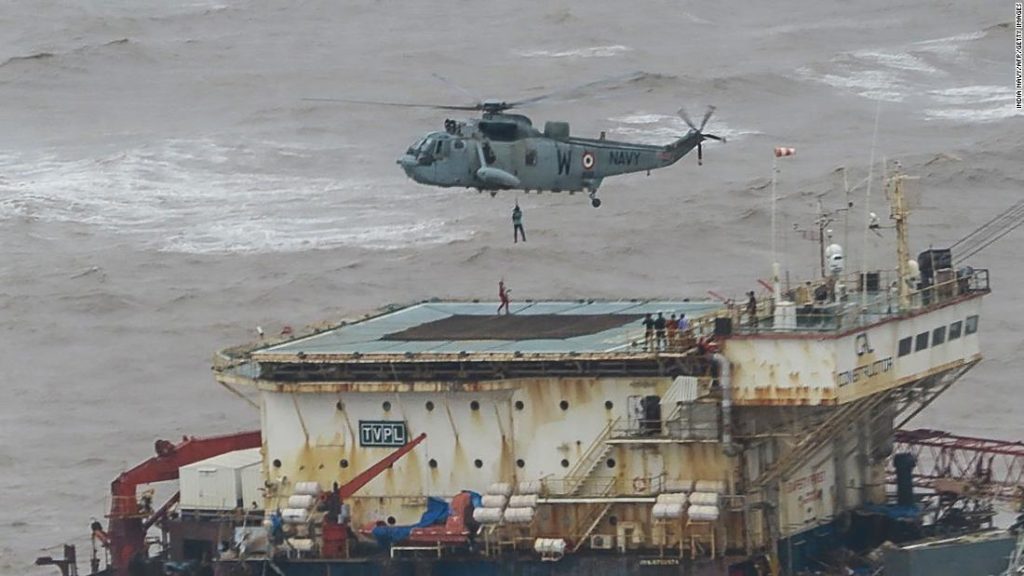Cyclone Tauktae, the strongest storm on record to hit India’s west coast, has killed at least 40 people since it made landfall in western Gujarat state on Monday night.
The cyclone formed in the Arabian Sea, and tore past the financial hub of Mumbai, in Maharashtra state, before reaching Gujarat. Its strong winds and heavy rain caused flooding and destruction in low-lying coastal regions, even before it made landfall.
Branches of the military, including the air force and navy, are now scouring the sea to rescue personnel on all operational oil rigs and vessels that were in the path of the cyclone.
One barge, operated by the Indian Oil and Natural Gas Corporation (ONGC), held a crew of 261 people when it sank in an offshore oilfield on Monday due to the force of the cyclone. The navy has rescued 186 crew members, and was searching for the remaining 75 on Wednesday morning, said navy spokesperson Vivek Madhwal.
“We have five ships in the area and two are coming back with the rescued personnel and remaining three are staying for search and rescue,” he said.
Late Tuesday, the navy said search and rescue operations would include helicopters and other naval assets, despite the “extremely challenging circumstances.”
Another barge, the Gal Constructor, ran aground off the west coast of Mumbai on Monday. The navy deployed a helicopter and several emergency vessels to evacuate the 137 crew members on board, all of whom are accounted for.
Two other barges are being towed to safety by ONGC tugboats, Madhwal said. ONGC is India’s biggest oil and gas company, with many of the barges used to service its offshore operations.
Mass evacuations
So far, deaths have been recorded in the western states of Maharashtra, Kerala, Karnataka, Gujarat and Goa.
Harshal Patel, the Gujarat relief commissioner, said Wednesday they were “accidental casualties” in the wake of the cyclone. Other state authorities have cited lightning strikes, building collapses, and the falling of trees and electricity poles as cyclone-related causes of deaths.
India’s Prime Minister Narendra Modi is expected to visit Gujarat later on Wednesday to conduct an aerial survey of districts impacted by the cyclone, according to the Gujarat chief minister’s office.
The cyclone had maximum sustained winds of 205 kilometers per hour (125 mph), equivalent to a high-end Category 3 hurricane, when it made landfall.
As of late Tuesday, it had weakened into a deep depression. It is expected to weaken further on Wednesday as it moves north into Rajasthan state, according to the Indian Meteorological Department.
In Gujarat, the hardest-hit state, 236,018 people were evacuated to 3,575 relief camps. The number of missing people is “yet to be assessed,” according to data from the State Emergency Operation Center on Tuesday night.
All Covid-19 hospitals remained operational during the cyclone, Patel said on Wednesday.
Though India’s daily new cases have trended downward in the past week, the International Federation of Red Cross and Red Crescent Societies warned Monday the cyclone posed “a terrible double blow” during the pandemic.
And daily deaths continue to rise. On Wednesday, the country reported 4,529 additional Covid-related fatalities — its highest daily toll since the start of the pandemic.
You may also like
-
Afghanistan: Civilian casualties hit record high amid US withdrawal, UN says
-
How Taiwan is trying to defend against a cyber ‘World War III’
-
Pandemic travel news this week: Quarantine escapes and airplane disguises
-
Why would anyone trust Brexit Britain again?
-
Black fungus: A second crisis is killing survivors of India’s worst Covid wave

